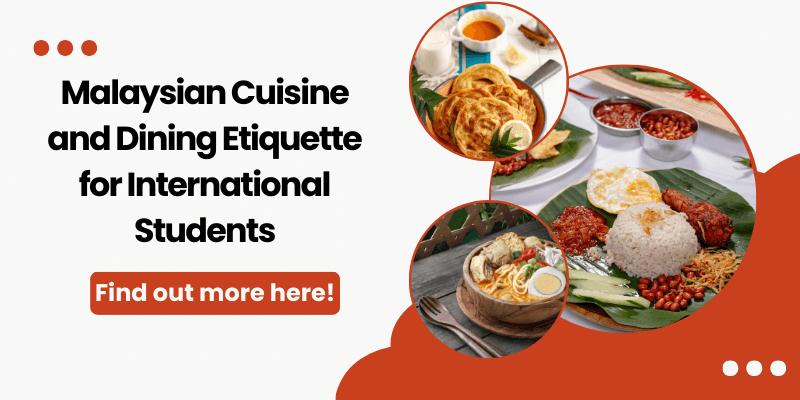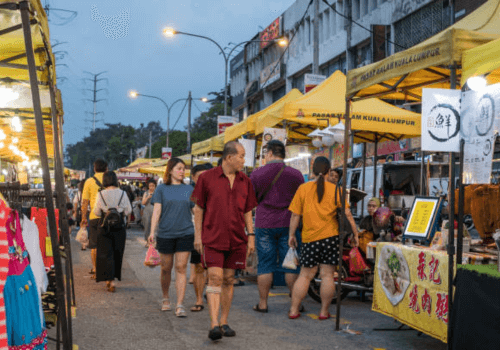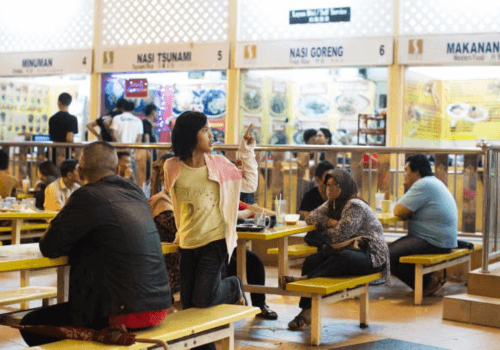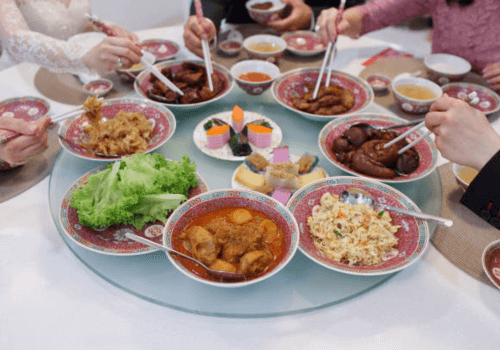Malaysian Cuisine and Dining Etiquette for International Students
May 29, 2024
Anis

Setting off on a food adventure in Malaysia during your study days introduces you to a mix of flavors influenced by different cultures—Malay, Chinese, and Indians traditions.
The blend of these cooking styles creates a tasty combination of flavors, textures, and aromas that make Malaysian food really special.
More than just a treat for your taste buds, Malaysian cuisine reflects the country's history and cultural heritage.
Each part of Malaysia has its own set of special dishes, with unique ingredients and ways of cooking that show off the local way of life.
As you explore Malaysian food, you won't just enjoy the country's unique flavors but also pick up insights into the cultural side of dining.
Malaysia's food scene isn't just about what's on the plate; it also includes how Malaysians share meals and their customs.
So, let's start a journey to discover the must-try Malaysian foods and cultural details that make Malaysian dining a diverse and delicious experience.
How do different cultures shape Malaysian foods?
Malaysian food is influenced by different cultures, such as Malay, Chinese, and Indian traditions. Each culture brings its uniqueness to the vibrant food scene.
For instance, Malays are known for their bold and aromatic flavors, using ingredients like coconut milk and spices. They love sharing meals and relish a mix of sweet, savory, and spicy tastes.
The Chinese community adds its touch with techniques like stir-frying and steaming, creating Malaysian-Chinese dishes that focus on preserving the natural flavors and colors of the ingredients.
On the other hand, Indians contribute a variety of spices, such as cumin and cardamom. Their influence is evident in popular dishes like curries and biryanis.
Over time, these cooking styles have blended, giving rise to a unique Malaysian culinary style. They embrace these techniques, creating dishes that showcase the harmonious fusion of cooking methods from different cultures.
As an international student in Malaysia, trying out local cuisines is an opportunity for you to learn about the country’s customs and traditions and connect you with the local community.
Where can you get Malaysian food?
As an international student in Malaysia, your educational journey is not complete without exploring the delicious local cuisine.
There are many places to get Malaysian foods, such as night markets, mamak, food courts, and street stalls. You will find a wide variety of foods to enjoy.
1. Night market (pasar malam)

Night markets are one of the best places to find local foods at an affordable price.
You can discover a variety of dishes such as char kuetiau, satay, murtabak, desserts, and sweet beverages, with prices ranging from RM 5 to RM 10.
These open spaces with bustling stalls are usually operating on specific days and are easily accessible via public transportation, such as LRT, MRT, or buses.
You can check the operational days and opening hours on the internet for your convenience.
2. Mamak
If you're looking for a lively place to hang out with your friends, mamak is the perfect choice!
Mamak stalls offer a wide variety of menu catering to various tastes. As early as 7 to 10 in the morning, you can try eating flaky bread-based foods such as roti canai, chapati, or tosei.
These crispy breads pair wonderfully with curry or sambal gravy. The price range for these morning selections typically falls between RM3 and RM7.
During the evening, gather with your friends and enjoy a meal like mee goreng mamak or nasi kandar. Nasi kandar, served with a selection of curries and side dishes, often comes in generous portions.
However, be mindful that each side dish has different prices. If you're on a budget, popular and cost-effective choices include vegetables and fried chicken.
Additionally, when dining at a mamak, don't miss trying the popular Malaysian drink, Teh Tarik. This frothy, hot, and sweet beverage complements any dish perfectly!
3. Food courts

In addition to night markets and mamak stalls, another great suggestion for trying Malaysian cuisine is to visit food courts, commonly found in shopping malls.
What makes food courts in Malaysia interesting is the wide variety of food choices available, ranging from local dishes to international cuisines. You can find options for Malaysian, Western, and Arabic food.
It's important to note that prices at food courts may be slightly higher compared to the night markets or mamak stalls.
Since food courts are often busy, some stalls may have long queues. So, how can you navigate the bustling atmosphere to get your meal?
You join the queue and, when you reach the cashier, let them know what dish you want.
Once you have made the payment, keep the receipt and patiently wait while the staff prepares your order. This might take some time, especially during peak hours.
You can wait either at your table or nearby the stall. Keep an eye out for the staff tapping the bell at the cashier counter, indicating completed orders.
Check your receipt, which includes the name of the food and the order number. After you have confirmed it, take your food and enjoy!
After enjoying your food, it's customary to clean up your own tray and dispose of any waste in the designated bins. This helps keep the food court clean and ensures a pleasant experience for everyone.
4. Street stalls
Another option to find more Malaysian food is to visit street stalls. You might be wondering about the differences between street stalls and night markets, since both of which are commonly found in Malaysia.
Night markets, as the name suggests, only open during night time. Typically, the vendors will set up their business at 6:00 pm and operate the business until 9:30 pm. Night markets are strategically set up at specific locations, such as parking lots.
You may find various items selling at the night markets, such as food, sweet beverages, toys, fresh fruits and vegetables, clothes, and more.
In contrast, street stalls operate on minimal space to sell their items. Unlike the varied offerings of night markets, street stalls have limited variations.
Although their variations are limited, you can still find delicious Malaysian foods, such as nasi lemak, nasi kerabu, bihun goreng, and an assortment of local kuih.
And the best part of street stalls is their price is affordable, typically ranging from RM3 to RM8, depending on what food you buy.
What are the traditional foods in Malaysia?
Besides enjoying the local foods mentioned in the previous section, you should also explore the delicious dishes served during Malaysian celebrations like Hari Raya Aidilfitri, Chinese New Year, and Deepavali.
These festive occasions offer a chance to try festive foods such as rendang, laksa, murukku, nasi biryani, yee sang, and more. These dishes have cultural importance and make the Malaysian culinary experience richer.
Understanding these foods is not just about taste; it helps you explore different cultures in Malaysia.
By embracing the variety of foods and traditions, you can enhance your time studying in the country and appreciate Malaysian culture more deeply.
Trying Malaysian foods also helps you connect with Malaysian friends and build relationships.
Sharing meals with them becomes a special experience that promotes cultural exchange and builds lasting connections.
Your openness to trying local dishes demonstrates your love for food and helps you integrate into Malaysian life.
Also read: Language and Communication Tips for International Students Studying in Malaysia
What are the dining etiquettes in Malaysia?
As an international student in Malaysia, you need to understand Malaysian dining customs to adapt to the local culture. Here are some general dining etiquettes in Malaysia:
1. Eating with hands or using utensils
Malaysians, particularly Malays and Indians, will eat using their right hand. This practice is due to their staple meal which is rice. So it is easier for them to mix rice with gravies like curry.
However, Malaysians use utensils like spoon, fork, knife, and chopsticks for noodle-based dishes or when attending special occasions.
During the event, a variety of foods are served, and utensils are provided for the guests' convenience.
Another important tip is to avoid your utensils touching the shared serving plates. The shared serving plates have separate utensils for serving and hygienic purposes.
2. Washing hands
Washing hands is another common custom in Malaysia. It emphasizes cleanliness before and after having a meal.
When you are about to have a meal, especially if it includes rice, you must wash your hands thoroughly.
3. Communal dining

Communal dining is a regular practice among Malaysians and often occurs in public establishments such as restaurants, university cafeterias, or Malaysian homes.
So what should you do during communal dining?
You need to take a small portion from the shared serving plates onto your plate instead of reaching across the table. This can be done by taking turns to serve or asking someone nearby for assistance.
4. Finishing your plate
Finishing all the food on your plate may be perceived as a positive sign, indicating your enjoyment of the meal. This practice also aligns with the values of moderation and appreciation for the meal.
However, it is acceptable if you leave a small amount of food to show that you are satisfied. Leaving a small portion on your plate is a considerate gesture, signifying that you have had enough without wasting much food.
5. Tipping
Unlike in some cultures, tipping is not a customary practice in Malaysia, especially in local eateries. Most restaurants apply a service charge directly to the bill, which is typically declared on the menu.
In conclusion, as you explore Malaysian cuisine and dining customs, you also encounter the country's diverse culture.
Trying local dishes is a way for you to learn about the local customs and traditions and connect you with the Malaysian community.
Treasure this experience to gain a deeper understanding and appreciation of Malaysian culture. It presents an opportunity to build lasting connections, making your study abroad journey even more exciting.
Kickstart your education in Malaysia
We'll help you find and apply for your dream university
You might be interested in...
- Global Learning at the Crossroads: Canada–Malaysia’s Evolving Education Partnership
- How AI is Powering the Next Wave of MSME Growth in Malaysia
- Sunway University Climbs to Global Top 500 in QS Rankings 2026
- Trusted by Top Universities: EasyUni’s Exclusive Visit to Sunway University
- Wawasan Open University and Sophic Automation Partner to Offer Work-Based Learning for Engineering Students
- Sunway University: Malaysia’s Best Cambridge A-Level College with 11 Years of Excellence
- Top Malaysian Universities in QS Asia Rankings 2025
- Sunway University launches New Medical School to transform Healthcare Education
- What to Do After IGCSE/O-Level? Best Study Pathways in Malaysia
- Xiamen University Malaysia Scholarships for International Students in 2025
 +60173309581
+60173309581





